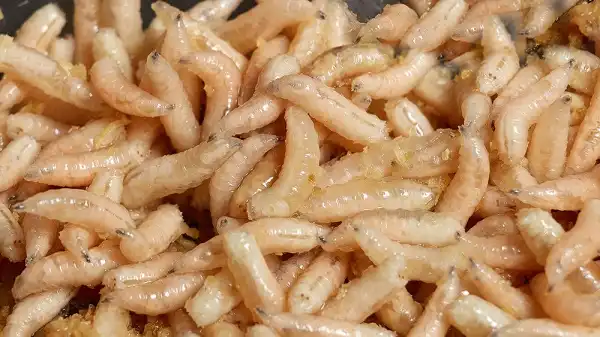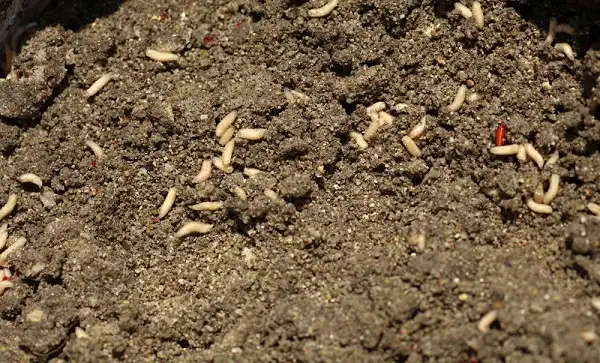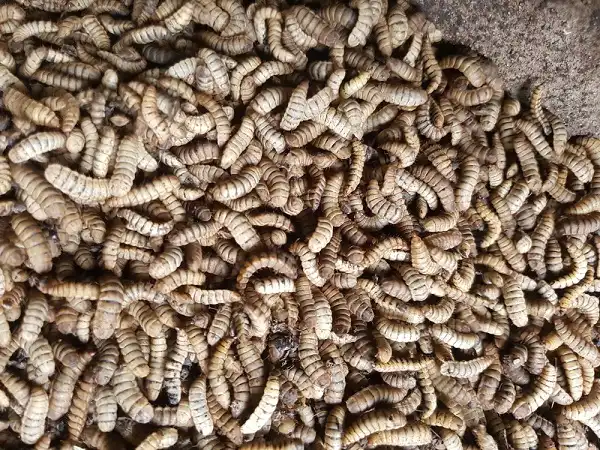Maggots are perhaps one of the most reviled creatures on Earth. These larval-stage insects are often associated with filth and decay, and their appearance can be truly gruesome. But did you know that maggots have some amazing abilities? Read on to learn more about these fascinating creatures!

Maggot Description
Maggots are small, white, legless larvae of flies that often emerge from decomposing or rotting organic matter. They have an elongated, curved body with a tapered head and a tiny black dot at one end. Maggots have no eyes, antennae, or legs; instead, they have hooks on their heads for feeding and crawling. Maggots breathe through spiracles on the sides of their bodies, but they are able to survive without oxygen for up to three days by entering a state of suspended animation called “diapause”. This is an important adaptation that helps them find food in otherwise inhospitable environments. Maggots also produce proteins that help them resist extreme environments, including desiccation, cold temperatures, and high levels of salt or acidity.
Maggot Habitat
Maggot habitats vary widely depending on the species, but they are generally found in moist, rotting organic matter such as compost piles, carcasses of animals or humans, and decaying plant material. Maggots prefer warm, humid environments with access to food sources such as bacteria and decaying matter. They can also be found in areas subject to frequent flooding or high levels of humidity. Some species are more tolerant than others and can survive in places with limited food, such as dry riverbeds. Maggots also inhabit urban environments where sanitation is poor, including sewers and garbage dumps. These creatures are scavengers, so they thrive in places where there are plenty of dead or decomposing organisms for them to feed on. Maggots are often the first invertebrates to colonize a new habitat—they will immediately start breaking down organic material which can then be used by other organisms.
Maggot Diet
Maggots feed primarily on decaying matter, such as animal carcasses and plant material. They consume bacteria by “rummaging” through the substrate with their mouths, then grinding it down with their mandibles into a paste which they swallow whole. Maggot diets vary depending on the species; some are omnivorous, consuming both plant and animal matter while others are more specialized, such as those that feed exclusively on mollusks or spiders. Some maggot species also eat fungi or algae if other food sources are scarce. The larvae can detect subtle changes in their environment which signals new sources of food nearby—for example, they can detect chemicals associated with a dead animal from several meters away! In addition to food scavenging from dead bodies and plants, maggots will sometimes feed on live prey if there is an abundance of it available. Predatory maggot species will seek out other small invertebrates such as worms and insect larvae before consuming them whole. Furthermore, some species even act as parasites: they attach themselves to larger animals such as cows or horses in order to feed off their blood supply!

Maggot Size
Maggot size can vary drastically depending on the species and environment. Within a single species, maggots may range from a few millimeters to up to 4 cm in length! Generally, smaller maggots will be more common as they tend to develop faster and require less food than larger larvae. Maggot size is largely determined by the amount of food available and the age of the larva. Maggots will stop growing if food sources become limited or if they have reached their adult size. Additionally, some species are better adapted to surviving in harsh environments; these maggots may be smaller than those found in more hospitable conditions due to their need for fewer resources. The growth rate of a maggot also depends on its temperature; warmer temperatures cause larvae to grow faster while cooler temperatures slow down development. In addition, some species are capable of overwintering as larvae which means they can survive extremely cold temperatures without any additional protection from predators or environmental stressors—these “cold-hardy” species often produce larger maggots when compared with other species.
Maggot Lifespan
The lifespan of a maggot can range from just a few days up to several weeks; generally, the longer-lived species are larger in size. The average lifespan for most maggot species is about 2 weeks, during which time they will feed and grow rapidly before pupating into an adult fly. The amount of food available, temperature, and surrounding environment all play a role in determining the length of a maggot’s life cycle. For instance, if it is too cold, the larvae may not mature quickly enough to survive the winter; this is why some species are better adapted to harsher climates than others and can overwinter as larvae. Furthermore, if food resources become limited then maggots may be forced to reduce their growth rate in order to conserve energy and nutrients—this will often lead to smaller maggots with shorter lifespans.
Maggot Behavior
Maggot behavior is largely determined by their size and the environment they inhabit. Smaller maggots tend to be less active than larger ones, and will often take shelter in dark areas such as rotting wood or decaying leaves while they feed. These larvae will also move more slowly due to their smaller size and lack of energy reserves. On the other hand, larger maggots are much more active and will search for food sources over large distances as well as explore their surroundings with greater agility. They can also defend themselves against potential predators with greater success due to their larger size. In addition, since larger maggots have greater energy reserves, they can survive for longer periods of time without food, allowing them to colonize new environments faster than their smaller counterparts. In terms of reproduction, adult flies lay eggs near suitable sources of food; once hatched the larvae will begin to feed voraciously until they reach maturity at which point they pupate into adults. This entire process happens within just a few weeks depending on the species’ average lifespan; this allows maggots to quickly populate areas with ample food sources so that other organisms may benefit from the nutrients produced by these creatures’ decomposing activities.

Maggot Speed
Maggot speed is determined by several factors including size, environment, and the availability of food sources. Smaller maggots tend to be much slower than larger ones because they have fewer energy reserves. They typically move slowly, taking refuge in dark areas such as decaying wood or leaves while they search for sustenance. On the other hand, larger maggots are more active and will often venture further distances in order to find food. In addition, their mobility is greatly enhanced due to their greater strength and size which allows them to escape predators and locate prey more efficiently. In terms of locomotion, most species use a combination of crawling (with the help of bristles) as well as fast-paced wriggling movements in order to travel forward; these motions create thrusts that propel them forward at speeds ranging from 0.2–1 cm/s depending on their size and environmental conditions such as temperature or moisture.
Maggot Hunting
Maggot hunting is a common activity among certain species of fly, as they use their senses to search for suitable sources of food. This behavior is primarily driven by their need to feed themselves and their young, while also providing sustenance for other organisms in the ecosystem. Maggots typically hunt by either following scent trails or actively seeking out prey through tactile exploration; they may even utilize vibrations in order to detect potential food sources within the environment. Furthermore, some species have evolved the ability to use visual cues such as motion and color in order to effectively target specific prey items. In terms of hunting techniques, maggots may employ a variety of methods depending on their size and preferred food source. Smaller species are usually more “sit-and-wait” hunters, relying on their sense of smell and taste to locate prey quickly; larger maggots may use more active tactics such as chasing after moving targets with speed and agility.
Some species may even exhibit complex behaviors such as using deception in order to fool unsuspecting victims into coming close enough for them to capture it. In addition, maggot hunting can be affected by environmental factors such as light intensity or air temperature; variations in these conditions can affect the speed at which they move or the effectiveness of their sensory organs during the search process. Furthermore, different species have adapted unique strategies for finding food depending on what resources are available within a particular ecosystem; this includes everything from stalking slow-moving prey items like slugs or earthworms to raiding ant colonies or termite mounds for tasty morsels.

Conclusion
Maggots are incredibly important organisms in the natural world, providing essential nutrients that sustain life within an environment. Through their unique behavior and adaptations, these creatures are able to find food sources on which to feed, helping maintain balance within ecosystems. With their powerful sense of smell and taste, as well as sensory organs used for detecting vibrations and visual cues, maggots can easily locate prey items; furthermore, they have evolved complex hunting strategies depending on what resources are available. As such, understanding these fascinating creatures can help us gain a greater appreciation for the intricate web of life found in nature.
Frequently Asked Question


